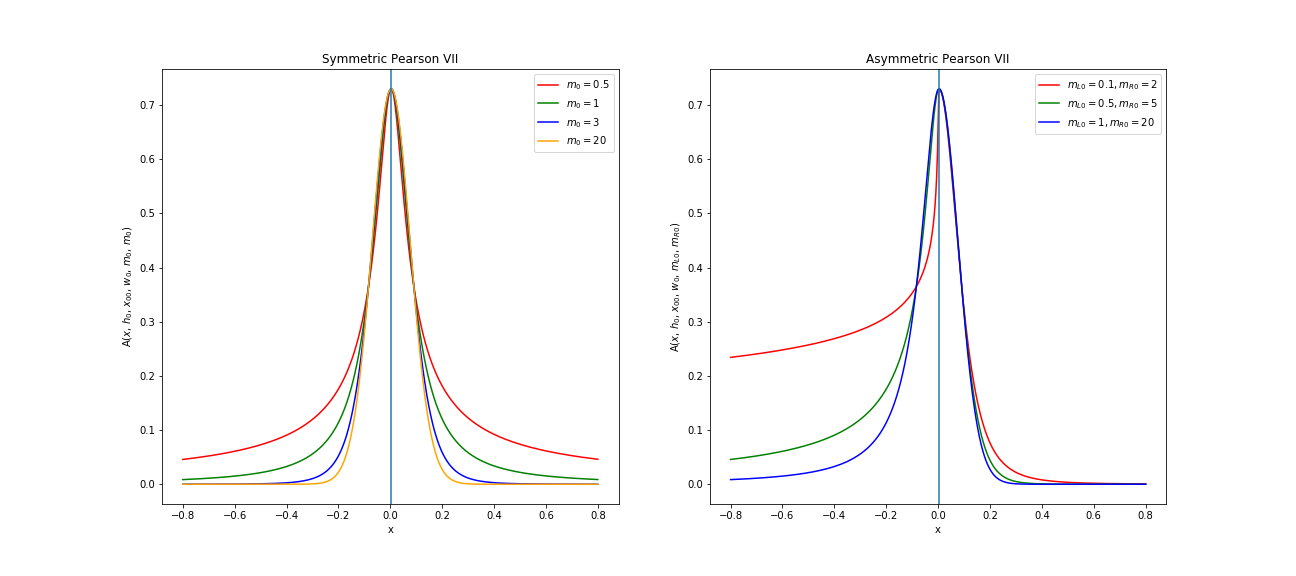\(\renewcommand\AA{\unicode{x212B}}\)
The asymmetric Pearson VII function (sometimes it is also referred to as the split-Pearson VII function) is a function that combines two Pearson VII distributions so to fit sharp peak curves [1]. It is useful for analysis of X-ray diffraction peaks which consist of two separable components.
In one of the representations, the asymmetric Pearson VII function \(A(x)\) can be written as a superposition of the “left” and “right” Pearson VII functions \(P_L(x)\) and \(P_R(x)\) [2],
where \(x_0\) is the value when the function changes between the left and right Pearson VII, and this is usually chosen to be the peak centre. Moreover, \(\theta\) denotes the Heavyside step function with \(\theta(y \ge 0) = 1\) and \(\theta(y < 0)=0\), and \(P(x)\) denotes the Pearson VII function. This function takes four additional parameters and in general is defined as
The four free parameters that the Pearson VII function \(P(x, h, x_0, \Gamma, m)\) takes represent the following quantities
The parameter \(m\) can take values in the range \([0, \infty)\) and it determines whether \(P(x, h, x_0, \Gamma, m)\) is more close to a Lorentzian or a Gaussian. When \(m=1\) it’s a Lorentzian, whereas when \(m \rightarrow \infty\) it’s a Gaussian. The “left” and “right” Pearson VII functions \(P_L(x)\) and \(P_R(x)\) take identical parameters \(h, x_0, \Gamma\), but diffent \(m\), so that
In other words, it is assumed that the asymmetric Pearson VII function uses two halves of the Pearson VII with a common peak hight, peak centre, and full width at half maximum. As a result, the asymmetric Pearson VII distribution takes five parameters: \(h, x_0, \Gamma, m_L, m_R\). For the sake of stability of the numerical implementation of asymmetric Pearson VII distribution in Mantid, one operates with the weight parameter \(w \equiv 1/\Gamma\), i. e. \(A = A(x, h, x_0, w, m_L, m_R)\).
Below is the list of analytic derivatives of \(P = P(x, h, x_0, w, m)\) with respect to \(h, x_0, w, m\):
where
The numerical calculation of \(P(x, h, x_0, w, m)\) and its partial derivatives is complicated by singularities as \(m \rightarrow 0\). For this reason, one needs to operate with a limit of the corresponding expressions:
The figure below illustrates the comparison of shapes between various symmetric [3] and asymmetric Pearson VII distributions plotted for \(h_0 = 0.7297\), \(x_{00} = 0.0035\), \(w_0 = 5.7215\).

| Name | Default | Description |
|---|---|---|
| PeakHeight | 1.0 | Hight of the peak |
| PeakCentre | 0.0 | Location of the peak |
| Width | 0.1 | Full width at half maximum |
| LeftShape | 1.0 | Left shape parameter |
| RightShape | 1.0 | Right shape parameter |
| [1] | Gupta, S. K. Peak Decomposition using Pearson Type VII Function, J. Appl. Cryst. (1998). 31, 474-476 |
| [2] | Lifshin, E. (Ed.). (1999), X-ray Characterization of Materials, WILEY-VCH, https://doi.org/10.1002/9783527613748 |
| [3] | http://pd.chem.ucl.ac.uk/pdnn/peaks/pvii.htm |
Categories: FitFunctions | XrayDiffraction